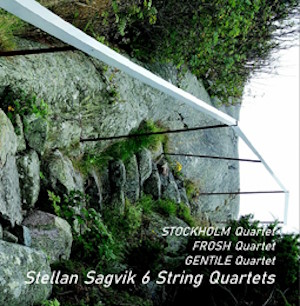
Stellan Sagvik (b. 1952)
String Quartet No. 1 (1971)
String Quartet No. 2 (1972)
String Quartet No. 3 (1973)
String Quartet No. 4 (1990)
String Quartet No. 5 (1994)
String Quartet No. 6 (2020)
Stockholm Quartet (1-3); Frosch Quartet (4-5); Gentile Quartet (6)
rec. 1993, Swedish Radio (1-3); 2022, Sofia (4-5); Flemingsberg (6)
Nosag Records CD2246 [2 CDs: 108]
Swedish composer Stellan Sagvik was born in Örebro. He has a prodigious worklist that includes opera (ten of them), string quartets, three symphonies, dance-dramas, choral, film and theatre music. His expressive style is said to be “very open, often beautiful and communicative … awaken[ing] emotions, feelings, views and rich sensations.”
Let’s take the first three quartets, all written in the first half of the 1970s. They are here played by the Stockholm Quartet in live performances from Swedish Radio. Live they may be but either they have been recorded without an audience or with one that is silent. The First (no other title) is a student work in four movements. Sagvik, who amongst much else is the driving force behind the Nosag label, says that the music was written while he was in the forest sitting down on a tree stump. It has a strong and buffeting melodic crest which combines with a splash of Bartókian astringency. On occasion it projects a ruggedly Schubertian jollity. The jovial is later subverted by wispy asides and from these episodes rise a yearning loveliness. The last two movements track through touching hesitancy and introspection just this side of melancholy. Finally, he finds the same mercurial merry-go-round as in the first movement.
The 10-minute Second Quartet resorts to the busily determined and the dartingly mordant; almost ruthless. The finale is a wild, tipping and tumbling witch-ride. The slightly more extended Third Quartet is in four micro movements. Unnervingly, the composer’s palette stretches from bitter-sweet drama – smacking of Smetana’s First Quartet with a 1970s accent – to singing themes that fade in and out like Hamlet’s father’s ghost. As it proceeds, Sagvik’s restless forward impulse is foregrounded until it dissolves into the creepier higher reaches of the instruments. The conclusion comes in the form of a tremble and a screech.
The Fourth Quartet “Ensemble Variations on a Warsaw Theme” is colourfully introduced in the liner booklet. It reflects the composer’s three days hard work in a hotel. The at first pervasive glissandi give impressions of the hot Warsaw autumn of 1990 – a stinking city: sewage, polluted water and body odour. Those glissandi call to mind a certain famous Threnody for the Victims of Hiroshima. Its headlong ways suggest the progress of a hay-wagon on eccentric, precarious splayed axles with the wheels about to come off. This ‘on the edge’ music engages the ear if not the heart. Its fascination is no mean strength. The impact of the experience is enhanced by great stereo separation that well serves the Frosch Quartet’s sessions in Sofia in 2022.
We encounter the admirable Frosch again for Quartet No. 5; presumably in the same sessions as those for its predecessor. The title (Ylanin Logoty) is an anagram of the musicians’ names. Each of the four movements has one of the instruments as its Lead or instigator or facilitator. There are yet more precarious glissandi as well as a hoarse viola which often sounds as if it is about to announce something. The penultimate movement has some discordant “Tziganerie”. This is followed by the leading voice patter of the cello which then ushers in Dali-like surreal-aural images.
The last quartet of this sequence is No. 6 which has Hawaiian movement titles: “La’au lapa’au” (medicine), “Make” (death) and “Hau’oli” (glad). Again we hear those squealing glissandi juxtaposed with peaceful sighing melodies. There’s a finale that has the musicians remorselessly picking their pizzicato ways forward. This work ends with a little rush like a no longer patient raptor bearing down on its hapless prey. This work was recorded by the Gentile Quartet in Flemingsberg Church.
Despite the disparity of dates and venues, in this set of Sagvik’s quartets the sound quality is thoroughly attractive and keeps pace with playing which is never less than obviously convinced. On top of this you also get (in the booklet) the composer’s reflections on each work.
Rob Barnett
Availability: Nosag


















